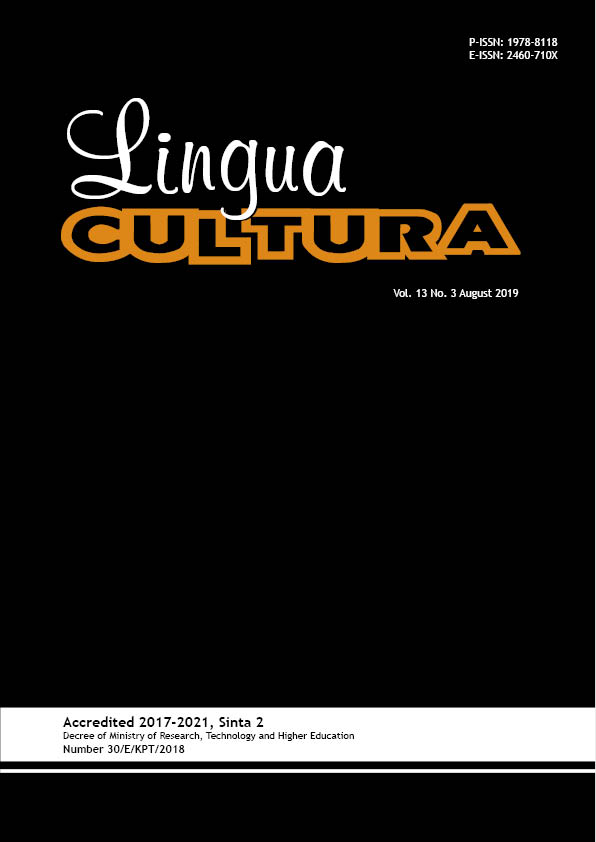Cucuk Lampah: Cooperative Principles Violations to Create Laughter at Wedding Ceremony in Magetan
DOI:
https://doi.org/10.21512/lc.v13i3.5747Keywords:
humor, violation cooperative principle, Cucuk LampahAbstract
This research aimed at describing the violations of cooperative principles and the factors that created humor of Cucuk Lampah in the wedding ceremony in Magetan regency. This was descriptive qualitative research. The subjects of this research were all humor discourse conducted by Cucuk Lampah. Meanwhile, the objects were the data that contained the violation of the cooperative principle. The data collection used observation method with the tapping technique, then SBLC or Free Participant Observation technique, note-taking technique, and video recording technique. It used a pragmatic identity method based on utterances by heuristic technique to analyze data. The result shows that in creating humor, Cucuk Lampah
mostly violates quantity maxim. It means that Cucuk Lampah prefers less and more information or contribution to the interaction. Cucuk Lampah is free to lie, using taboo, speaking indirectly with pambiwara, and singers. Cucuk Lampah also uses language play by mentioning the unexpected in the utterances to build up taboo words. The violations of the quality maxim, relevance maxim, and manner maxim are also done in less number compare to quantity maxim violations. The nonobservance of the maxims mostly is violating a maxim, flouting a maxim, infringing a maxim, suspending a maxim, and the last is opting out of a maxim
References
Amianna, J. N. R. P., & Putranti, A. (2017). Humorous situations created by violations and floutings of conversational maxims in a situation comedy entitled “How I Met Your Motherâ€. Journal of Language and Literature, 17(1), 97–107. https://doi.org/10.24071/joll.2017.170110.
Anisah, Z. (2016). Polisemi pada wacana humor Indonesia Lawak Club. AL HIKMAH: Jurnal Studi Keislaman, 6(6), 152–167.
Firmansyah, B., & Rokhmawan, T. (2016). Representasi bahasa humor dalam acara Stand Up Comedy di Metro TV. KEMBARA: Jurnal Keilmuan Bahasa, Sastra, dan Pengajarannya, 2(2), 195–202.
Floranti, A. D., & Saifullah, A. R. (2016). Strategi penciptaan humor pada meme. Proceedings of the Four International Conference SETALI. Bandung, Indonesia. pp 52–56.
Grice, H. P. (1975). Logic and conversation. NewYork: Academic Press.
Jenny, T. (1995). Meaning in interaction: An introduction to pragmatic. London & New York: Longman.
Lestari, T. P. (2015). Pelanggaran prinsip kerjasama sebagai sarana pengungkapan humor dalam wacana lisan komika Dodit Mulyanto. Proceedings of the Second National Conference Prasasti. Surakarta, Indonesia. pp 296–301.
Listiyorini, A. (2017). Wacana humor dalam meme di media online sebagai potret kehidupan sebagian masyarakat Indonesia. Litera, 16(1), 64–77. https://doi.org/10.21831/ltr.v16i1.14251.
Nurfarida, L., & Tustiantina, D. (2017). Deskripsi wacana humor dalam upacara adat pernikahan sebagai wujud pelestarian tradisi lisan di masyarakat. Jurnal Membaca (Bahasa dan Sastra Indonesia), 2(2), 127–137. doi: http://dx.doi.org/10.30870/jmbsi.v2i2.2707.
Pandin, M. G. R. (2018). Nilai estetis humor ludruk: Perspektif DeWitt Parker. Proceeding Icon-Elite, 1(1), 72–82.
Putra, P. P., Mulawarman, W. G., & Purwanti. (2018). Pembentukan humor Stand Up Comedy one-liner Indra Frimawan (Suci 5 Kompas TV): Tinjauan struktur pragmatik). Jurnal Ilmu Budaya, 2(4), 357–370. doi: http://dx.doi.org/10.5281/ilmubudaya.v2i4.1464.
Rifa’i, S. N. (2016). Kajian penyimpangan prinsip kerjasama dalam wacana humor on line. Proceedings of the Third International Conference Prasasti. Surakarta, Indonesia. pp 254–259.
Sukardi, M. I., Sumarlam., & Marmanto, S. (2018). Penyimpangan makna dengan homonimi dalam wacana meme (Kajian semantik). LiNGUA: Jurnal Ilmu Bahasa Dan Sastra, 13(1), 23-34. https://doi.
org/10.18860/ling.v13i1.4513.
Suryaningtyas, V. W., & Setyaningsih, N. (2018). Multiculturalism in Javanese humor (A case study in “Sing Lucu†rubric on Panjebar Semangat magazine). Lensa: Kajian Kebahasaan, Kesustraan, dan Budaya, 8(1), 102–116.
Tiani, R. (2017). Strategi pragmatik dalam penciptaan humor di televisi. Nusa: Jurnal Ilmu Bahasa dan Sastra, 12(2), 42-51. https://doi.org/10.14710/nusa.12.2.42-5112(2), 42–51.
Wijana, I. D. P. (2004). Kartun: Studi tentang permainan bahasa. Yogyakarta: Ombak.
Yule, G. (1996). Pragmatics. Oxford: Oxford University Press.
Yuwana, R. Y. (2019). Strategi penciptaan materi humor: Analisis transitivitas. LEKSEMA: Jurnal Bahasa Sastra, 4(1), 1–10. https://doi.org/10.22515/ljbs.v4i1.1478
Downloads
Published
How to Cite
Issue
Section
License
Authors who publish with this journal agree to the following terms:
a. Authors retain copyright and grant the journal right of first publication with the work simultaneously licensed under a Creative Commons Attribution License - Share Alike that allows others to share the work with an acknowledgment of the work's authorship and initial publication in this journal.
b. Authors are able to enter into separate, additional contractual arrangements for the non-exclusive distribution of the journal's published version of the work (e.g., post it to an institutional repository or publish it in a book), with an acknowledgment of its initial publication in this journal.
c. Authors are permitted and encouraged to post their work online (e.g., in institutional repositories or on their website) prior to and during the submission process, as it can lead to productive exchanges, as well as earlier and greater citation of published work.
USER RIGHTS
All articles published Open Access will be immediately and permanently free for everyone to read and download. We are continuously working with our author communities to select the best choice of license options, currently being defined for this journal as follows: Creative Commons Attribution-Share Alike (CC BY-SA)


















